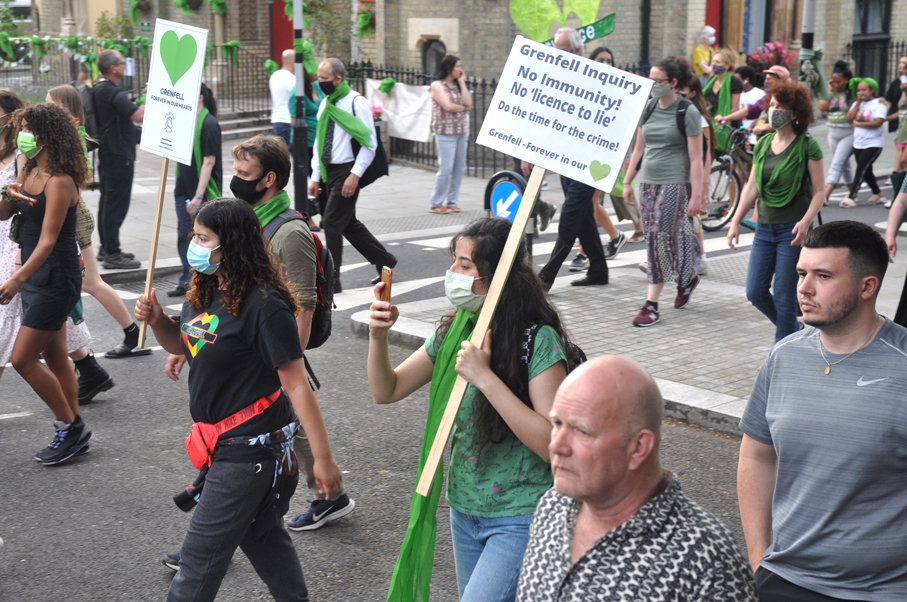
‘DAMPER’ devices placed in Grenfell Tower’s ventilation system to prevent the spread of smoke were of the ‘lowest possible standard’, the ongoing Grenfell inquiry into the fire was told last week.
The session’s opening statement to the Inquiry – now in Week 38 – saw representatives of the bereaved families set out their criticisms of the smoke control systems installed in the block.
The ‘dampers’ are – supposedly – devices installed in air ducts to close in the event of fire so as to prevent further spread.
Then, in response, lawyers for the bereaved families and survivors of the fire, which killed 72 people, highlighted findings in expert Dr Barbara Lane’s report which said that the poor quality of dampers used had ‘failed to prevent the spread of smoke in the building’ at the time of the fire.
Stephanie Barwise QC, who represents bereaved families, told the inquiry: ‘The dampers used were the lowest possible standard, namely fire dampers, when they should have been smoke-control dampers.’
Barwise also noted that the installer of the system, PSB UK, has since April 2018 had to ‘explain the basis of its design, and yet has failed to do so’. She continued: ‘The suggestions now made in PSB’s … opening submissions are no more than creative afterthought, which is not – as yet at least – supported by an expert.’
She noted too that it isn’t yet clear whether PSB had consulted an independent expert regarding the compliance of its system which could possibly counter Dr Lane’s findings.
The inquiry also heard accounts of a number of residents in the tower who recalled the spread of smoke in communal areas impeding their escape.
And representatives of the bereaved claimed the selection of the lowest possible damper standard was an ‘egregious failure which put relevant persons at unnecessary additional risk’, and also said the design team responsible lacked competence.
PSB however has denied the claims relating to dampers. Lee Bennett, the organisation’s representative, said the system provided was appropriate and offered an ‘appropriate means of escape’.
Addressing the concerns about the dampers used, Bennett said: ‘Our position is that is a misconceived submission because it is premised on an incorrect interpretation of the relevant guidance and industry practice by Dr Lane in relation to this particular piece of equipment.’
And beyond the criticisms of the smoke control system, PSB even denied that – even if there were failings in it – this could have contributed ‘significantly’ to the overall fire.
Bennett told the inquiry: ‘In the context of a catastrophic cladding fire, such as happened at the tower, even if the alleged failings of the system were to be established with confidence, PSB presently sees no basis upon which to reasonably draw any conclusion that such failings caused or materially contributed to the outcome of the fire.’
Meanwhile, the company contracted to deliver repairs for Kensington and Chelsea Tenant Management Organisation (KCTMO), Repairs Direct, has denied claims that it had sought to bolster customer satisfaction rates through a ‘selective feedback’ approach.
Graham Webb was managing director of Repairs Direct from January 2016 to November 2017. Speaking to the Inquiry, however, he denied accusations that the company sought to improve customer feedback rates by targeting cases that would likely deliver favourable results.
Webb, who took over Repairs Direct in January 2016, was shown a witness statement from one of his former employees which suggested the feedback she had gathered did not give an accurate reflection of customer satisfaction.
Former employee Samantha Burrell’s witness statement said: ‘We had to maintain over a 90%-95% satisfaction rate, so if I was to make 10 calls who gave marks under six, I would have to call another 10 residents to make sure the percentage went higher.
‘However in my view these statistics did not provide a true picture of the repairs carried out.
‘When I commenced employment with Repairs Direct, the ethos was to select specific jobs which was almost guarantee a positive reaction to the works, for example, a tap repair, to bolster the percentage.’
Asked whether he recognised these methods, Webb emphasised: ‘Absolutely not. My firm belief was that calls were selected at random.’
Webb was also shown testimony from residents on the Lancaster West Estate that showed the extent of residents’ dissatisfaction with repairs by his company, which was a wholly owned subsidiary of KCTMO.
One resident at Grenfell had complained about becoming trapped in their flat after having a new flat entrance door installed. When an operative from Repairs Direct came to fix it they offered to take the self-closing mechanism out for the resident.
Webb said that he could not explain why this offer had been made and that he was ‘disappointed if that is the case’.
Nearly two-thirds of fire door self-closers were missing from flat entrance doors in Grenfell Tower. This has been blamed for crucial loss of compartmentation in the fire, allowing smoke to spread through the building.